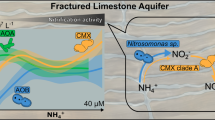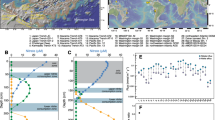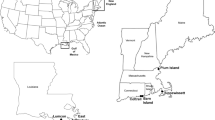Abstract
Nitrification, the oxidation of NH4+ to NO2− and subsequently to NO3−, plays a central role in the nitrogen cycle and is often a critical first step in nitrogen removal from estuarine and coastal environments. The first and rate-limiting step in nitrification is catalyzed by the enzyme ammonia monooxygenase (AmoA). We evaluate the relationships between the abundance of ammonia-oxidizing archaea (AOA) and ammonia-oxidizing bacteria (AOB) amoA genes; potential nitrification rates and environmental variables to identify factors influencing AOA abundance and nitrifier activity in estuarine sediments. Our results showed that potential nitrification rates increased as abundance of AOA amoA increased. In contrast, there was no relationship between potential nitrification rates and AOB amoA abundance. This suggests that AOA are significant in estuarine nitrogen cycling. Surprisingly, more of the variability in potential nitrification rates was predicted by salinity and pore water sulfide than by dissolved oxygen history.
Similar content being viewed by others
Main
The long-held view that ammonia oxidation was restricted to relatively few genera in β- and γ-Proteobacteria has changed following the discovery that amoA occurs in Crenarchaeota (Francis et al., 2005, 2007; Treusch et al., 2005; Beman and Francis, 2006). In addition, a Crenarchaeota, Nitrosopumilus maritimus, has been isolated that is capable of nitrification and contains the amoA gene (Konneke et al., 2005). However, little is known about whether ammonia-oxidizing archaea (AOA) are significant nitrifiers in marine and estuarine environments.
Critical environmental variables known to affect nitrification rates include temperature (Kaplan, 1983; Henriksen and Kemp, 1986), salinity (Jones and Hood, 1980; Rysgaard et al., 1999), dissolved oxygen (DO) concentrations (Kaplan, 1983; Henriksen and Kemp, 1986), NH4+ availability (Jones and Hood, 1980; Kaplan, 1983; Henriksen and Kemp, 1986), light (Ward, 2000) and sulfide concentrations (Joye and Hollibaugh, 1995).
We measured potential nitrification rates; characteristics of bottom water and sediments; and abundance of ammonia-oxidizing bacteria (AOB) and AOA amoA genes in six different estuaries at multiple sites (Supplementary Table 1). Three estuaries were sampled repeatedly (Supplementary Table 1). Sampling sites differed in salinity of overlying water; and in sediment chlorophyll a, extractable NH4+ and sulfide concentrations of sediment pore water. Bottom water DO variability ranged from sampling sites that were often hypoxic (DO <2 mg l−1) to sites that never went hypoxic (Supplementary Table 1).
The abundance of AOA amoA genes was significantly higher than AOB amoA (Figure 1; t-test P=0.001). AOB amoA dominated only in samples from Weeks Bay, particularly at the Fish River site (Figure 1 inset). Log abundance of AOA amoA and AOB amoA was significantly correlated with one another (r=0.56, P=0.001; Supplementary Table 2). We found that AOA amoA genes were more abundant, often as much as 80 times greater than AOB amoA genes. However, this relationship was not consistent, with one of the estuaries having a higher abundance of AOB amoA than AOA amoA. Our results contrast with previous studies showing that AOAs were two to three orders of magnitude more abundant than AOBs in the open ocean (Wuchter et al., 2006; Mincer et al., 2007) and in soils (Leininger et al., 2006).
Abundance of amoA genes for ammonia-oxidizing archaea (AOA) and ammonia-oxidizing bacteria (AOB) normalized relative to prokaryotic DNA for six different estuaries (see Supplementary Table 1). The relative abundance of amoA genes is expressed by normalizing amoA gene abundance to the number of copies of prokaryotic (bacteria+archaea) 16S rRNA genes in each sample. A one-to-one line is included for reference. Inset shows abundance of amoA genes for AOA and AOB relative to prokaryotic DNA for Weeks Bay.
Potential nitrification rates were significantly, positively correlated with AOA amoA gene abundance in samples from Pensacola Bay and Sapelo Island (Figure 2). There was no relationship between potential nitrification and abundance of AOB amoA genes at any site (P>0.13 at all sites). Across all sites, abundance of AOA amoA genes was positively correlated with salinity (r=0.51, P=0.04), while AOB abundance was not (r=0.16, P=0.39). Salinity at the study sites ranged from 0 to 38, with two sites being relatively oligohaline, while two sites were euryhaline (Supplementary Table 1). Abundances of both AOB and AOA amoA genes were greatest at low temperatures (Supplementary Table 2). AOA amoA was negatively correlated with pore water sulfide (r=−0.46, P=0.02). Potential nitrification rates were not significantly correlated with any single environmental variable. However, a multiple regression model revealed that potential nitrification could be best predicted by sediment chlorophyll a, salinity, bottom water DO and AOA amoA gene abundance, with sediment chlorophyll a explaining the most variability and AOA amoA explaining the least (Supplementary Table 3; R2=0.51, P=0.001). The conditions leading to the highest rates of potential nitrification occurred when salinity and bottom water DO were low, and sediment chlorophyll a and AOA amoA abundance were high. In contrast to previous studies, potential nitrification rate was not related to AOB amoA abundance (Cebron et al., 2003; Dollhopf et al., 2005).
AOA amoA abundance normalized to prokaryotic DNA versus potential nitrification (PN) in micromoles per gramws per day, labeling same as Figure 1. Least-squares regression lines are shown for Pensacola Bay (r=0.66, P=0.01) and Sapelo Island (r=0.80, P=0.003).
Salinity is important in controlling the abundance of AOB (Stehr et al., 1995; Cebron et al., 2003) and nitrification rates (Rysgaard et al., 1999; Cebron et al., 2003), with higher abundances of AOB and greater nitrification rates in freshwater than marine end-members. We were surprised that the relationship between potential nitrification rates and AOA amoA abundance was not stronger as was observed in Wuchter et al. (2006). This may be due to the small-scale spatial heterogeneity of sediments compared to the open ocean. Because potential nitrification rates are measured under optimal conditions, we expected rates to scale with abundance of the nitrifying community. This suggests that environmental variables related to salinity, DO and sediment chlorophyll a are as and sometimes more important than genetic potential in controlling potential nitrification rates.
Both phytoplankton and microphytobenthos can contribute to sediment chlorophyll a concentrations in shallow, photic estuarine sediments. It represents a labile source of organic nitrogen, which is then mineralized to NH4+. Alternatively, the relationship between chlorophyll a and potential nitrification may result from microphytobenthos and nitrifiers, both responding to the same environmental conditions, such as the supply of NH4+. Our results suggest that nitrification may be maximized when DO is present and labile organic matter is high, but pore water sulfide is low, similar to results found in experimental microcosms (Caffrey et al., 1993). Furthermore, our findings suggest that AOA rather than AOB are responsible for much of the nitrification in estuarine sediments as has also been observed in the Black Sea (Lam et al., 2007).
References
Beman JM, Francis CA . (2006). Diversity of ammonia-oxidizing archaea and bacteria in the sediments of a hyper-nitrified subtropical estuary: Bahia del Tobari, Mexico. Appl Environ Microbiol 72: 7767–7777.
Caffrey JM, Sloth NP, Kaspar H, Blackburn TH . (1993). Effect of organic loading on nitrification and denitrification in a marine sediment microcosm. FEMS Microbiol Ecol 12: 159–167.
Cebron A, Berthe T, Garnier J . (2003). Nitrification and nitrifying bacteria in the Lower Seine River and Estuary (France). Appl Environ Microbiol 69: 7091–7100.
Dollhopf SL, Hyun J-H, Smith AC, Adams HJ, O'Brien S, Kostka JE . (2005). Quantification of ammonium-oxidizing bacteria and factors controlling nitrification in salt marsh sediments. Appl Environ Microbiol 71: 240–246.
Francis CA, Beman JM, Kuypers MMM . (2007). New processes and players in the nitrogen cycle: the microbial ecology of anaerobic and archaeal ammonia oxidation. ISME J 1: 19–27.
Francis CA, Roberts KJ, Beman JM, Santoro AE, Oakley BB . (2005). Ubiquity and diversity of ammonia-oxidizing archaea in water columns and sediments of the ocean. Proc Natl Acad Sci USA 102: 14683–14688.
Henriksen K, Kemp WM . (1986). Nitrification in estuarine and coastal marine sediments: methods, patterns and regulating factors. In: Blackburn TH, Sørensen J (eds). Nitrogen Cycling in Coastal Marine Environments. John Wiley and Sons: New York, pp 207–250.
Jones RD, Hood MA . (1980). Effects of temperature, pH, salinity and inorganic nitrogen on the rate of ammonium oxidation by nitrifiers isolated from wetland environments. FEMS Microbiol Ecol 6: 339–347.
Joye SB, Hollibaugh JT . (1995). Influence of sulfide inhibition of nitrification on nitrogen regeneration in sediments. Science 270: 623–625.
Kaplan H . (1983). Nitrification. In: Carpenter EJ, Capone DG (eds). Nitrogen in the Marine Environment. Academic Press: New York, pp 139–190.
Konneke M, Bernhard AE, de la Torre JR, Walker CB, Waterbury JB, Stahl DA . (2005). Isolation of an autotrophic ammonia-oxidizing marine archaeon. Nature 437: 543–546.
Lam P, Jensen MM, Lavik G, McGinnis DF, Muller B, Schubert CJ et al. (2007). Linking crenarchaeal and bacterial nitrification to anammox in the Black Sea. Proc Natl Acad Sci USA 104: 7104–7109.
Leininger S, Urich T, Schloter M, Schwark L, Qi J, Nicol GW et al. (2006). Archaea predominate among ammonia-oxidizing prokaryotes in soils. Nature 442: 806–809.
Mincer TJ, Church MJ, Taylor LT, Preston C, Karl DM, DeLong EF . (2007). Quantitative distribution of presumptive archaeal and bacterial nitrifiers in Monterey Bay and the North Pacific subtropical gyre. Environ Microbiol 9: 1162–1175.
Rysgaard S, Thastum P, Dalsgaard T, Christensen PB, Sloth NP . (1999). Effects of salinity on NH4+ adsorption capacity, nitrification, and denitrification in Danish estuarine sediments. Estuaries 22: 21–30.
Stehr G, Bottcher B, Dittberner P, Rath G, Koops H-P . (1995). The ammonia-oxidizing nitrifying population of the River Elbe estuary. FEMS Microbiol Ecol 17: 177–186.
Treusch AH, Leininger S, Kletzin A, Schuster SC, Klenk H-P, Schleper C . (2005). Novel genes for nitrite reductase and Amo-related proteins indicate a role of uncultivated mesophilic crearchaeota in nitrogen cycling. Environ Microbiol 7: 1985–1995.
Ward BB . (2000). Nitrification and the marine nitrogen cycle. In: Kirchman D (ed). Microbial Ecology. Wiley-Liss: New York, pp 427–454.
Wuchter C, Abbas B, Coolen MJL, Herfort L, van Bleijswijk J, Timmers P et al. (2006). Archaeal nitrification in the ocean. Proc Natl Acad Sci USA 103: 12317–12322.
Acknowledgements
This research was supported by grants from the National Science Foundation Ocean Sciences (to JMC and JTH). We thank Lee Edmiston, Apalachicola Bay NERR (National Estuarine Research Reserve); Dorset Hurley, Sapelo Island NERR; Scott Phipps, Weeks Bay NERR; Mike Shirley, Rookery Bay NERR and Kerstin Wasson, Elkhorn Slough NERR for logistical support and water quality data. We thank Kristin Smith, Elizabeth Gaige, Angelique Smith, Tanner Martin, Fran Aftanas, Nathaniel Davila, Matt Wagner and Dean Pakulski for their assistance in field and laboratory.
Author information
Authors and Affiliations
Corresponding author
Additional information
Contributors: JMC and JTH conducted fieldwork and wrote the paper, NB and KK performed quantitative PCR analysis. All authors discussed the results and commented on the manuscript.
Conflict of interest
The authors state no conflict of interest.
Supplementary Information accompanies the paper on The ISME Journal website (http://www.nature.com/ismej)
Supplementary information
Rights and permissions
About this article
Cite this article
Caffrey, J., Bano, N., Kalanetra, K. et al. Ammonia oxidation and ammonia-oxidizing bacteria and archaea from estuaries with differing histories of hypoxia. ISME J 1, 660–662 (2007). https://doi.org/10.1038/ismej.2007.79
Received:
Revised:
Accepted:
Published:
Issue Date:
DOI: https://doi.org/10.1038/ismej.2007.79
Keywords
This article is cited by
-
Research advances of ammonia oxidation microorganisms in wastewater: metabolic characteristics, microbial community, influencing factors and process applications
Bioprocess and Biosystems Engineering (2023)
-
Quantitative Responses of Active Ammonia-Oxidizing Archaea and Bacteria to the Biological and Abiotic Factors Across Functional gene Distribution in Coastal Wetlands
Wetlands (2023)
-
Transitions in nitrogen and organic matter form and concentration correspond to bacterial population dynamics in a hypoxic urban estuary
Biogeochemistry (2023)
-
Heterogeneous selection dominated the temporal variation of the planktonic prokaryotic community during different seasons in the coastal waters of Bohai Bay
Scientific Reports (2022)
-
Nitrogen removal processes coupled with nitrification in coastal sediments off the north East China Sea
Journal of Soils and Sediments (2021)





